Like most herb-loving cooks, I want flavor that sings — not preservatives that read like the ingredients of a high school science project. Over the years, I’ve slowly reimagined some of the most common pantry staples — chili powder, bouillon, and lemon pepper — because the store-bought versions left me with two options: flavor I didn’t love, or ingredients I couldn’t pronounce.
So I started making my own. Here's how (and why) I did it.
Chili Powder — Minus the Mystery
My favorite chili powder used to be a rich, dark red blend. I loved the color. The flavor? Not so much. After a closer look at the label, I learned it included: cayenne (yes!), salt (fine), dextrose (wait, sugar?), sunflower oil, and silicon dioxide — which is essentially powdered sand used to prevent clumping. Technically "natural," but not the kind of natural I want in my seasonings.

And the flavor? Surprisingly bland. Turns out, salt cuts heat, and dextrose adds sweetness, so the cayenne barely had a chance.
I started blending my own. I used paprika and turmeric for rich color, added just the right amount of cayenne for kick, and rounded it out with garlic, onion, and oregano. The result is a bold, balanced chili powder with zero additives — just herbs doing what herbs do best. We use it in Fiesta Dip, BYP Chili Blend, Spicy Popcorn Sprinkle, and Spicy Salt Substitute as well as our Black Bean and Farmhouse Bean Medley Soup Mixes.
Bouillon, But Make It Vegan
Bouillon is traditionally a meat-based flavor booster — great for soups, but not exactly a win with my vegetarian and vegan customers. I tried all-herb blends for depth, but something was missing. That “brothy backbone” just wasn’t there… until I discovered nutritional yeast.

Nutritional yeast (or “nooch,” if you're in the know) is a deactivated yeast loaded with flavor and nutrients. It's a powerhouse of protein, B vitamins, minerals, and gut-friendly fiber. And best of all — it’s low-sodium, gluten-free, and totally plant-based. Basically, it’s a golden flake of culinary magic.
Now I use it as the base for my herb-rich, salt-free bouillon. It’s the secret to giving our soup mixes that satisfying, savory richness — no meat, no mystery, no MSG. Just honest, comforting flavor that plays nice with everyone at the table. You will find it in all but one of our soup mixes, and if you have food sensitivities, the bouillon is generally in a separate package and can be removed if needed.
The Lemon Pepper That Started It All
 Lemon Pepper may sound like a zesty, citrusy seasoning — but most commercial blends are really just lemon salt. The ingredients list starts with salt (surprise!) followed by black pepper, lemon zest, citric acid, silicon dioxide, and lemon oil. A sprinkle might be tasty, but for me, it always tipped toward too salty.
Lemon Pepper may sound like a zesty, citrusy seasoning — but most commercial blends are really just lemon salt. The ingredients list starts with salt (surprise!) followed by black pepper, lemon zest, citric acid, silicon dioxide, and lemon oil. A sprinkle might be tasty, but for me, it always tipped toward too salty.
This was actually the first seasoning I ever reinvented — way back in the 1990s! I started experimenting with ways to keep the lemony zing without the sodium overload. After some trial and error (and a few lemony flops), I found the right balance using lemon peel, white and black pepper, onion, and garlic. I skip powdered herbs to preserve freshness, but I don’t skip on flavor.
The result? A bright, savory lemon pepper substitute that brings all the tang with none of the salt. We list it among our Seasoning Blends and add it to our Good Luck Soup Mix.
Why It Matters
For me, making these blends from scratch isn’t just about ditching additives — it’s about putting flavor and wellness first. I want to know what’s in my food, and I want you to know too. When I say “herb blend,” I mean actual herbs — no hidden sweeteners, no powdered rocks, and definitely no ingredients you need a degree in biochemistry to decode.
Each of these staple substitutions — chili powder, bouillon, and lemon pepper — was born from a mix of curiosity, frustration, and the belief that we can have bold, beautiful flavor without compromise.
And now that I’ve created them, I use them in everything — dips, soups, dressings, you name it.
Because great cooking shouldn't come with a side of preservatives.

